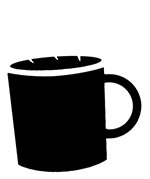Prickly Porky Giant Coffee Mug
Image features a porcupine and the warning "Back Off!" Customize by adding your own additional text on the reverse side.
Porcupines are indigenous to the Americas, southern Asia, and Africa and come in various shades of brown, grey, and the unusual white. Porcupines' spiny protection resembles that of the unrelated hedgehogs and echidnas. The name porcupine comes from Middle French porc espin (spined pig) A regional American name for the animal is quill pig. The North American porcupine, Erethizon dorsatum, has the northernmost range of all the world's porcupines. The quilled pelage of the porcupine makes it unique among North American mammals. Quills cover the body, except on the legs and belly. The quills are modified hairs which have microscopic barbs on the tips and are filled with a spongy matrix. Porcupines make a wide variety of sounds ranging from whimpers to screams, depending upon the circumstance. When the porcupine is relaxed, the hair and quills lie flat and point backwards. When threatened, the porcupine draws up the skin of the back to expose quills facing all directions, and it then presents its formidable bristling back. The porcupine tries to keep its back facing the attacker and strikes back and forth with its tail. Contrary to popular belief, a porcupine can not throw its quills. However, quills are readily dislodged on impact which may give the impression that quills can be thrown. The porcupine can be easily approached and killed with a club because of its plodding gait. This trait has saved the lives of hungry Natives, trappers, and miners in times past. Some people find the meat too strong, but in some areas of the state, porcupines with their heavy layer of fat are considered a delicacy. Quills sewn onto deerskin used to be the trading wampum of the Northeastern Indian tribes. Quills are still used for decoration by the Athabaskans of Interior Alaska. Natives used to kill porcupines just for their quills, but today Alaska Natives corner the animal and then tap the back of the animal with a styrofoam paddle to collect all the quills they need. The quills are dyed with locally obtainable vegetable materials and then sewn into skin clothing, earrings, and artistic items. Porcupines can be injurious to commercial forests and reforestation projects by feeding on the terminal buds or eating the bark all the way around the trees. When such problems occur, site specific control may be necessary, although within most of Alaska porcupines are not numerous enough to do much damage.
$24.25

